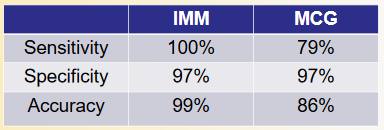Introduction
Buprenorphine, an opiate antagonist is metabolized by N-dealkylationto norbuprenorphine, followed by glucuronide conjugation of both buprenorphine (BUP) and norbuprenorphine (nor-BUP) for excretion in urine.Immunoassays which do not detect norbuprenorphine are subject to higher false negative rates since not all specimens from buprenorphine users contain the parent drug.
Objectives
- To evaluate the analytical performance of two commercially available urine buprenorphine immunoassays: Immunalysis (IMM) & Microgenics (MCG)
- To assess the importance of the different characteristics of the assays
IMM has almost identical cross-reactivity (100%) with both free BUP and nor-BUP; MCG has cross reactivity with free BUP and conjugated BUP but no nor-BUP cross-reactivity.
Methods
In the MCG assay: since extensive cross-reactivity with opiates and opiate glucuronides has been observed, the use of an elevated cut-off concentration of 30ng/mL rather than 5ng/mL has been suggested (1).
- MCG screening cut-off set to 20ng/mL as proposed by a reference laboratory rather than 30ng/mL as suggested in the literature, in an attempt to minimize both false negatives due to non-detection of nor-BUP; and false positives due to cross-reactivity with opiates and other glucuronides
- IMM screening cut-off set to the IMM recommendation of 5ng/mL (since no opioid cross reactivity was observed at this level)
- Specimens from patients treated with BUP and from patients taking other opiates were analyzed using both homogeneous enzyme immunoassays (HEIA)
- All specimens were additionally analyzed by LC-MS/MS for BUP, nor-BUP and corresponding glucuronides at a cut-off concentration of 5ng/mL
Results and Discussion

14 specimens were discrepant using the MCG assay. 13 were confirmed as false negatives of which five contained free norbuprenorphine at concentrations >20ng/mL; the rest had free buprenorphine <20ng/mL. One was a false positive compared to LC-MS/MS. The IMM assay produced one false negative result.
In further specificity testing, the MCG assay gave false positive results with100 g/mL concentrations of dihydrocodeine, codeine and norpropoxyphene, while the IMM assay showed no response at that concentration.
Summary

When compliance testing is the main goal of an application, a high false negative rate due to the inability to detect the metabolite norbuprenorphine is a drawback. In 515 specimens taken from daily users of BUP the positive rates for BUP, Nor-BUP, BUP-glucand Nor-BUP glucwere 1.2%, 63.9%, 89.9% and 96.5% respectively (2). While MCG assay detects BUP-gluc, other opiate glucuronides potentially present in urine may lead to false positives.
Reference
- PavlicM et al. IntJ Legal Med119(6); 2005:378-81
- Kacinko S. et al. ClinChem55(6); 2009: 1177-87
Toxicology 2010
To view the full study and its data, visit this link.
Looking for a unit for your urine immunoassay applications? Check out our featured products below.